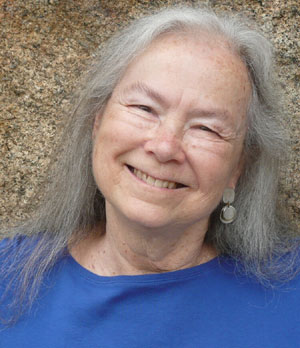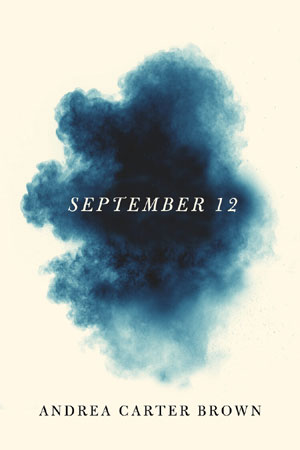|
In September 2001, Andrea Carter Brown lived a block from the twin towers of the World Trade Center.
She could see them out her apartment window. The morning of the attack, she was reading the newspaper when the phone rang. Her sister Deborah in North Carolina asked if she was OK.
"…Are you OK? Sure. Pause.Why? On "Good Morning America" I just saw a plane fly into
the World Trade Center. Didn't you hear anything? I walk to the far end of the living room. The North Tower is so close, I must raise the sash and stick my head out to see the
top. Dark rivers of smoke pour through windows licked by flames; a thick gray tornado's snout rises from the roof. That tower will fall. I couldn't be more sure. I have to flee. I
run back, slam down the phone, in dirty clothes, no bra or belt, lock up, get as far as the elevator, run back to grab my almost dead cell phone, leave for the second time. 9:03
a.m. 9/11 begins for me." —from "September 12" in September 12 by Andrea Carter Brown

How does one write a book to describe such a horror and have an audience?
The Steiny Road Poet has been thinking about this and realizing in a way she had not done before that war had broken out against the United States
with that day's three instances of terrorism—the World Trade Center attack, the Pentagon attack, and the hijacking to an unknown destination of United
Flight 93. Unlike the Pentagon attack and the downing of United Flight 93, the fall of the Trade Center's twin towers displaced people living nearby.
While Angel, her building's doorman, tells her not to worry, the poet knows
he is only doing his job and that he is unquestionably wrong. So, what does she do? She decides to stay close to the Hudson River and to head further
downtown in the opposite direction that everyone else is running. She provides maps in her book showing where she traveled that day.
"More terrified of flying glass, of being burned alive, or crushed, of not
being able to out-run the mob staring up when panic struck, I head south, stick close to the water. I'll jump in if the towers fall, let the current carry
me away, tread water until some boat rescues me. And if not, I'd rather drown." —from "September 12" in September 12 by Andrea Carter Brown

Brown's book contains five sections in this order:
—Cloud Studies: Hudson River School
—September 12th
—The Rock in the Glen
—To the Dust
—The Present
Section I, features Brown's own Hudson River School of art. The eight
poems are landscapes and portraits that depict love of New York on the Hudson, her husband, friends (like poet Molly Peacock) and historic and
contemporary notables who are usually New Yorkers but not always. What we, the readers, should understand is that Brown saw the Hudson River as a
potential sanctuary during her escape from the burning towers. A favorite of this section is "Each Boat Signs the Water" which is formatted in an
impressionistic version of what waves look like. Here are the first two stanzas.
Each boat signs the water with its wake, the way
a thumb print matches no other, or whales,
when they dive, leave a signature,
a calm so specific, biologists can
tell which individual swims
below their boat before
the whale surfaces
to breathe.
I've watched the river two years now. By now
I know the names of tugs, the ebb and flow
of tankers and barges, when the next
bright yellow banana boat
comes in. I've caught
at dawn an ocean
liner cruise
into port.
"Each Boat Signs the Water" is an homage to Gertrude Stein's good friend
Guillaume Apollinaire and his best-known poem "Le pont Mirabeau"—The Mirabeau Bridge. Under the Mirabeau Bridge flows the Seine River.
Apollinaire's poem concerns how fleeting love is. Brown's format is also a nod to Apollinaire's Calligrams, a collection of concrete poems.
Section III, "The Rock in the Glen" memorializes the eleven lives lost on
9/11 in Glen Rock, NJ, a town that Brown lived in as a child.
THE ROCK IN THE GLEN
Homage to Whitman
Picture a pretty town, peaceful, stately
trees lining its streets, children walking
to school weekday mornings. Picture
cars, bikes, and pedestrians converging
on the two train stations at the same time,
the hurried goodbyes. Picture a quietness
after the commuters leave, the pretty town
like Sleeping Beauty waiting to be kissed
awake when they return. Picture the spill
of play, parties, and gossip across yards
without hedges or fences. Picture a breeze
rustling the oaks and maples, spreading
the news the morning of September 11.
Picture a pretty town brought to its knees.
The metaphors of Sleeping Beauty (innocence and vitality) and knees (utter
defeat) economically sum up the blow suffered. Brown is a meticulous writer who is careful with the craft of poetry.
Section IV with its 19 poems deals with the aftermath of 9/11, the daily fear
and anger for what happened. Brown and her husband are told to get over it. Sometimes the poems present as stories ("The Kiss"), reports ("Shopping
Spree, September 13th"), bits ("After the Disaster: Fragments"), questions ("The Old Neighborhood"), live accounts ("Pilgrimage"), pictures
("Pinstriped Bullies"), directivies ("Burial Instructions"). In this section, Steiny finds the answer to how Andrea Carter Brown keeps her audience in
this remarkable collection of poetry about death, destruction, and terrible consequences.
ARS POETICA
Let's not romanticize bodies
falling. Others may use float
or dance; I refuse to pretend.
They were not graceful, quiet.
They fell unbelievably fast.
Straight down. Head first.
Some screamed. The sound
they made landing? Forget
thud. Louder than the wind.
The ten poems of Section V "The Present" begin with this graffiti quote, "Every day is a gift, that's why we call it the present." The last section is a
meditation on home (a new home in California) and country as well as living. It brings us up to the present with such lines as these:
TO THE WTC HEALTH REGISTRY
May, 2020
Nineteen years later, the latest survey
arrives in an email in the middle
of the pandemic.
The deceased recently exceeded the total
killed on 9/11, the US soldiers
dead in Viet Nam.
In this poem, Brown doesn't sugar coat the aftermath of 9/11. She still has
trouble sleeping because she frequently dreams, she died. She says she believes her life has been shortened and she wheezes with asthmatic
episodes. She answers the World Trade Center survey because she thinks her answers might do others good and she hopes in the future her survey
answers will yield more responses of seldom, almost never, and not at all.
Coming full circle from the first poem in the book ("The Magic Hour"),
"Domestic Karma," as the last poem, is a love poem set in Brown's backyard where now there are citrus trees, hens, chicks, and clean laundry being hung
out to dry. It's an ironic but loving jab at the alternative—airing one's dirty laundry. While "The Magic Hour" begins, leaning on the balustrade like spoons,/ your arms around my midriff, "Domestic Karma" refers to Clean
underwear/ made fresh for the body you love/ to undress.
Andrea Carter Brown's September 12.000000000000000000 is a
collection of poems that will both steal away your breath and make you sigh in admiration for the love in it.

September 12 was published by The Word Works and launched September
12, 2021. Andrea Carter Brown is an award-winning author of three previous collections of poetry.
Author Photo by Thomas Drescher
|